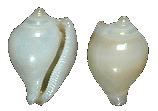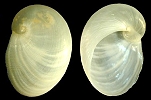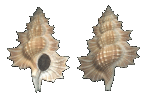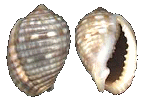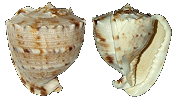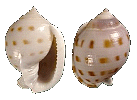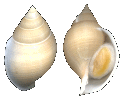2.
Subclass: ORTHOGASTROPODA Ponder & Lindberg, 1996
[= PROSOBRANCHIA Milne Edwards, 1848 p.p. + OPISTHOBRANCHIA;
= AZYGOBRANCHIA Spengel, 1881 p.p.] |
| |
SuperOrder: Caenogastropoda |
| Order:
Hypsogastropoda |
| |
SubOrder: Sorbeoconcha
|
| Unnamed |
| |
SuperFamily:
Cerithoidea |
| |
Family: Thiaridae
(Swamp Ceriths)
Freshwater
molluscs. The general range of the thiaridae is circum-tropical, and many
of the species are extremely widespread. Their dispersal is facilitated
by the fact that all are parthenogenic females.
|
| |
|
Genus: Melanoides,
Ripalania
|
|
Unable
to locat image
|
Melanoides
tuberculata
(Müller, O.F., 1774)
to 21 mm
URL
|
Ripalania
|
|
Family:Cerithiidae
(Horn shella)
Their shells are elongate and
high spired.They have a short but distinct anterior canal. The sculpture
consists of beaded spiral cords, axial ribs and nodules. Size range is quite
wide. Form, colour and sculpture is also quite varied. They live in tide
pools to depths of approximately 60 meters. |
| |
SubFamily: Species
inquirenda |
| SubFamily:
Cerithiinae |
| |
Genus: Cerithium,
Rhinoclavis, Colina, Plesiotrochus, Gourmya, Clypeomorus, Pseudovertagus,
Royella, Clavocerithium, Glyptozaria
|
|
|
|
|
|
|
Rhinoclavis
(Rhinoclavis) gemmata
(Hinds, R.B., 1844)
25 - 40 mm
Gastropods.com
|
|
Plesiotrochus
monachus
(Crosse, H. & P. Fischer, 1864)
24 mm
Gastropods.com
|
|
|
|
|
|
|
|
Clypeomorus
batillariaeformis
(Habe, T. & S. Kosuge, 1966)
8 - 25 mm
Gastropods.com
|
Pseudovertagus
aluco
(Linnaeus, C., 1758) Aluco Vertagus
45 - 95 mm
Gastropods.com
|
|
|
Unable
to locate image
|
Unable
to locate image
|
|
|
|
Clavocerithium
Gastropods.com
|
Glyptozaria
Gastropods.com
|
|
|
|
| SubFamily:
Bittiinae |
| |
Genus: Bittium,
Argyropeza, Cacozeliana, Varicopeza, Ittibittium
|
|
Unable
to locate image
|
|
|
|
Argyropeza
Deep Sea Mollusc
|
|
|
Unable
to locate image
|
Unable
to locate image
|
|
|
Varicopeza
|
Ittibittium
|
|
|
Family: Dialidae
They have a small (approx 2-7mm.) shells. The aperture is complete. |
| |
|
Genus:Finella,
Scaliola, Diala, Cerithidium, Mellitestea, Paradiala
|
Unable
to locate image
|
|
|
|
Finella
Gastropods.com
|
|
|
|
Unable
to locate image
|
Unable
to locate image
|
Unable
to locate image
|
|
Cerithidium
|
Mellitestea
|
Paradiala
|
|
| Family:
Diastomatidae |
| |
|
Genus: Diastoma
|
Unable
to loacate image
|
|
Diastoma
|
|
| Family:
Litiopidae |
| |
|
Genus: Litiopa,
Alaba
|
Unable
to loacate image
|
|
|
Litiopa
|
Alaba
incerta
(Orbigny, 1842)
5 mm.
|
|
Family:
Fossaridae
Shells are small and turbiniform, usually umbilicate and they usually
have a prominent protoconch. The last whorl is large, the apertureolbilque,
and the columella is connected to the outer lip. Often, spiral sculpture
predominates the shells. The operculum is thin and horny, with an upstanding
nucleus and open spiral. |
| |
|
Genus:
Fossarus,
Conradia, Larinopsis
|
|
Unable
to loacate image
|
Unable
to loacate image
|
|
Fossarus
ambiguus
(Linnaeus, 1758)
5 mm.
|
Conradia
|
Larinopsis
|
|
Family:
Modulidae
These shells resemble turban shells, but they are entirely porcelaneous
and there is a projecting tooth-like structure at the base of the columella.
The aperture is lirate. The operculum is chitinous and multispiral. |
| |
|
Genus: Modulus
|
| Family: Obtortionidae
|
| |
|
Genus: Obtortio,
Eufenella, Clathrofenella
|
Unable
to locate image
|
Unable
to locate image
|
Unable
to locate image
|
|
Obtortio
|
Eufenella,
|
Clathrofenella
|
|
Family:
Potamididae
(Horn Shells)
This is a common snail of the mangrove swamps in the Indo-Pacific.
|
| |
|
Genus:
Incertae
sedis:
Potamides (Pirenella) layardi , Potamides (Pirenella) layardi var bombayanus
Telescopium,
Potamides, Cerithidea, Terebralia, Pirenella
|
|
|
|
Telescopium
telescopium
(Linnaeus, C., 1758)
48 - 110 mm
Gastropods.com
|
Potamides
conicus
(Blainville, H.M.D. de, 1826)
12 - 23 mm
Gastropods.com
|
|
|
|
Unable
to locate image
|
|
|
Terebralia
semistriata
(Mörch, O.A.L., 1852)
57 mm
Gastropods.com
|
Pirenella
|
|
|
Family:
Siliquariidae
(Worm Snails)
These snails have diverted from a helically coiled shell form, uncoiled
completely and have developed into worm-shaped shells that often are
cemented to the substratum. These"worm snails" form massive
snail reefs that appear to be in global decline. As more-or-less sessile,
gill-filtering or slime-net-feeding organisms they fill unusual niches
among the gastropods. |
| |
|
Siliquaria
anguina
(Linnaeus, C., 1758)
20 - 80 mm.
|
|
| |
|
Genus:
Siliquaria, Stephopoma |
Family:
Turritellidae
(Deep Sea Augers, True Augers)
"Shells of this family are shaped like long, slender augers or
screws and resemble Terebridae shells. However, the similarity ends
there. The turritella shell shape is somewhat variable, and shells
are thin, rough and not lustrous. The rounded mouth and complete absence
of a siphonal canal at the anterior end of the aperture clearly identify
turritellas. The shells have in addition: a very tall spire; numerous
convex whorls; no umbilical opening; absence of folds on the columnella,
and a horny, flexible operculum that is supported by flexible bristles.
..." Archerd
Collection |
| |
|
Turritella
cochlea
( Reeve, 1849)
50 - 63mm
|
|
| |
SubFamily: Turritellinae
|
| |
Genus:
Turritella,
Haustator, Zaria, Archimediella, Colpospira, Gazameda, Maoricolpus, Zeacolpus,
Spirocolpus, Neohaustator, Banzarecolpus |
| SubFamily:
Turritellopsinae
|
|
Unable
to locate image
|
|
| |
Genus:
Turritellopsis
|
| Family:
Orectospirinae
|
|
Orectospira
shikokuensis (Yokoyama 1928)
5 mm.
URL
|
|
| |
|
Genus:
Orectospira |
Family:
Planaxidae
This small (Shell
1.5-2.5cm),relatively common snail grazes
on algae on rocky areas. The deep, smooth circular ridges on the shell
are quite diagnostic.
|
| |
|
|
|
| |
|
Genus:
Planaxis,
Fissilabia, Hinea, Holcostoma, Couthouyia, Angiola, Halotapoda, Simulathena
|
Family:
Batillariidae
The shells are heavy and high-spired, somewhat similar in shape
to those of the Cerithiidae, with spiral and axial sculpture, but
usually with a flaring outer lip. The animals inhabit estuarine habitats,
and are often found in mud between mangroves. Capricornica
|
| |
|
Batillaria
minima
(Gmelin, 1791)
20 mm.
|
|
| |
|
Genus:
Pyrazus,
Batillaria, Zeacumantus, Batillariella, Velacumantus |
| |
|
|
SuperFamily:
Rissoidea
The shell of the Rissoidea vary
in shape and sculpture, but most have a spire higher than the aperture. |
| |
Family:
Assimineidae
They are small, amphibious,
air breathing snails inhabiting brackish water estaries on tropical
and semitropical continental coatlines and islands. |
| . |
|
Assiminea
lutea
Adams, A., 1861
8 mm
|
|
| |
|
Genus:
Incertae sedis
Assiminea,
Omphalotropis, Austroassiminea |
Family:
Bithyniidae
Small freshwater snails |
|
Bithynia
tentaculata
(Limnnaeus, 1758)
8 mm. up
|
|
| |
|
Genus:
Incertae sedis
Gabbia |
Family:
Hydrobiidae
Hydrobiids are small to very minute
usually conical, operculate fresh or brackish-water snails of considerable
antiquity. The family has world-wide
distribution. |
| |
|
Mercuria
confusa
(Frauenfeld,1863)
to 5 mm.
|
|
| |
|
Genus:
Incertae sedis
Unplaced
Potamopyrgus, Hemistomia, Tatea, Beddomeia, Fluviopupa,
Fluvidona, Jardinella, Phrantela, Posticobia, Ascorhis, Fonscochlea, Trochidrobia
|
Family:Iravadiidae
Iravadiidae shells are elongate, always
higher than broad and mostly smaller than 5mm. Shells smooth or with
spiral sculpture. A diagnostic feature for the family is the planorbid
or depressed dome-shaped protoconch, which has two whorls, the first
one of which is minute. The animals live in shallow water, mostly
in mangrove habitats, some live in brackish water, but some live in
deep water. Capricornica |
| |
|
Iravadia
(Fluviocingula) elegantula
( Adams A. 1861)
to 3 mm.
|
|
| |
|
Genus:Ceratia,
Iravadia, Rissopsis, Chevallieria, Nozeba,Liroceratia |
Family:
Stenothyridae
Very small snails which
inhabit the brackish water on mudflats |
| |
|
Stenothyra
edogawaensis (Yokoyama, 1927)
2 mm
|
|
| |
|
Genus:
Incertae sedis
Stenothyra |
Family:
Truncatellidae
Inhabit salt marshes and
the supra-littoral zone where they live on the surface of mud or under
leaf litter |
| |
|
Truncatella
pulchella
(Pfeiffer, 1834)
to 6 mm.
|
|
| |
|
Genus:
Truncatella |
| Family:
Rissoidae
|
| |
SubFamily:
Rissoinae
The shell is thin to moderately
solid, variously sculptured or smooth. The aperture is shallowly channeled
anteriorly and posteriorly |
| |
|
Alvania
cancellata
(Costa, E.M. da, 1778)
2 - 5 mm
|
|
| |
Genus:Cingula,
Alvania, Onoba, Manzonia, Pusillina, Benthonella,
Merelina, Lironoba, Attenuata , Parashiela, Lucidestea, Powellisetia, Voorwindia
|
SubFamily:
Rissoininae
Shell is tall-spired, usually quite solid and variously sculptured
or smaooth The aperture is ovate,typically channeled anteriorly and
posteriorly S |
| |
|
Rissoina
inca
(Orbigny, A.D. d', 1840)
7 mm.
|
|
| |
Genus:
Unplaced
Rissoina, Zebina,
Microstelma, Stosicia, Lamellirissoina |
| Family:
Tornidae
|
|
Tornus
subcarinatus
(Chaster, 1897)
1 - 2.8 mm
|
|
| |
|
Genus:
Tornus, Laciniorbis, Naricava, Tropidorbis, Uzumakiella |
Family:
Vitrinellidae
Minute shells which are transparent when
the animal is alive but it becomes apaque white after death.The shells
are low and flattened, almost always wider than higher. The shells
is porcelaneous, umbilicate and often have a collus pad. The protoconch
is small and glassy. |
| |
|
Callomphala
lucida
(Adams, A. & G.F. Angas, 1864)
1 mm
|
|
| |
|
Genus:
Unplaced
Vitrinella,
Teinostoma, Callomphala, Circulus, Pseudoliotia, Lodderia, Lydiphnis, Scrupus,
Anticlimax, Moeniatoma, Ponderinella, Latilabrum |
SubFamily:
Caecinae
Minute curved shells, sometimes referred to as false tooth shells
because of their tubular forms. Caecids start out with a spiral shell
but then grow without any further coiling and the tube eventually
falls off. They lead a benthic existence in algae-sand flats of tidepools
to depths of several hundred meters. The aperture of the adult is
circular and there is a horny operculum |
| |
|
Caecum
pulchellum
(Stimpson, 1851)
2 mm.
|
|
| |
Genus:
Caecum |
| SubFamily:
Pedumicrinae |
|
Unable
to loacate image
|
|
| |
Genus:
Parastropia, Ctiloceras, Jayella, Enigmerces, Ponderoceras |
SubFamily:
Streblocerinae
These small shells (2-3 mm.) are glossy, translucent, thin, vitreous
and cornucopia shaped. |
| |
|
Strebloceras
subannulatum
(DeFolin, 1879)
2.6 mm.
|
|
| |
Genus:
Strebloceras |
Family:Barleeidae
Their shells are simple,
smooth and typically red-brown. Yhe operculum is thick with a straight
peg and longitutdinal thick ridge |
| |
|
Barleeia
unifasciata
(Montagu, G., 1803)
1 - 2 mm
|
|
| |
|
Genus:
Barleeia, Protobarleeia |
Family:Anabathridae
The shells are conical to high-spired and
typically possess a pitted protoconch and a chitinous inner shell
layer. They live in shallow water on hard substrates. |
|
Photo
in Black and White
|
|
Pisinna
glabrata
(Muhelfedt, 1824)
1 mm.
|
|
| |
|
Genus:
Amphithalamus, Anabathron, Pisinna, Microdryas, Badepigrus, Pseudestea,
Afriscrobs |
| Family:
Pelycidiidae
|
|
Unable
to loacate image
|
|
| |
|
Genus:
Pelycidion |
| Family:
Epigridae |
|
Unable
to loacate image
|
|
| |
|
Genus:
Epigrus |
| Family:
Emblandidae |
|
Unable
to loacate image
|
|
| |
|
Genus:
Emblanda |
| Family:
Elachisinidae
|
|
Unable
to loacate image
|
|
| |
|
Genus:
Elachisina |
| |
|
|
SuperFamily:
Stromboidea
|
| |
Family:
Strombidae (True
conchs) They are carnivorous.
"The shells of this family show five unusually distinctive genera,
each of which has its own popular name; e.g., Strombus ("conches"),
Lambis ("spider shells"), Terebellum ("torpedos"), Tibia
("shinbone shells"), and Varicospira ("beak shells")...."
Archerd Collection |
| |
|
Genus:
Strombus, Lambis, Terebellum, Tibia, Rimella(Varicospira
) |
|
Strombus
|
Lambis
|
Terebellum
|
Tibia
|
Rimella
|
|
|
|
|
|
|
|
Stombus
gigas
(Linnaeus, 1758)
to 350 mm
|
Lambis
(Lambis) lambis
(Linnaeus, 1758)
90 - 275 mm
|
Terebellum
terebellum
(Linnaeus, 1758)
32 - 75 mm
|
Tibia
(Tibia) fusus
(Linnaeus, C., 1758)
150 - 310 mm
|
Rimella
crispata
(Sowerby, G.B. I, 1842)
20 - 30 mm
|
|
Family:
Struthiolariidae
(Ostrich Foot Shells) They
are filter feeders much like bivalves!
"Ostrich Foot molluscs
are almost wholly restricted to New Zealand and parts of Australia.
They live in clean water no deeper than about 20 m. and burrow, leaving
two openings in the sand above, through which they evidently filter
feed. ..." Archerd
Collection |
|
|
|
Struthiolaria
papulosa
(Martyn, T., 1784)
to 80 mm
|
|
| |
|
Genus:
Struthiolaria, Perissodonta, Tylospira |
Family:
Aporrhaidae (Pelicans Foot)
"Only seven known species of the Pelican's Foot shell have been
found, some of which are from the deep sea and rare. The Common Pelican's
Foot is found in muddy gravel. All live in cool, boreal, waters. Like
the Strombidae, (another family in the superfamily, Strombacea) the
Aporrhaidae are actively carnivorous...." Archerd
Collection |
| |
|
Aporrhais
pespelecani
(Linnaeus, C., 1758)
26- 55 mm.
|
|
| |
|
Genus:
Aporrhais, Drepanocheilus |
| |
|
|
SuperFamily:
Cypraeoidea |
| |
| Family:
Pediculariidae |
| |

Pedicularia californica
(Newcomb, 1864)
6 mm. |
Jenneria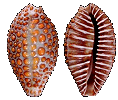 pustulata
pustulata
(Lightfoot, J. in Solander, 1786)
to 27 mm.
|
|
| |
|
Genus:
Pedicularia |
|
Family: Cypraeidae
"A very deep coating of enamel on the outer surface gives the
the shell a brilliantly polished appearance, naturally. In life, two lobes
of the cowrie's mantle extend out and over the dorsal surface of the shell,
meeting at midline, and they continually deposit enamel while protecting
the shell from abrasion. Interestingly, the mantle has a totally different
color and pattern than the shell. If startled or touched the cowrie can
suddenly change colors by withdrawing its mantle completely inside the
shell, thus confusing a predator.
Although the shell seems to be bilaterally symmetrical, the newest whorl
completely covers the previous whorls. Well developed teeth are found
on both sides of the lengthwise aperture slit. Cowries are nocturnal and
feed on algae around coral reefs. ..." Archerd
Collection
"The animals
of the Cypraeidae are nocturnal and hide in crevices during the day. Most
are herbivores, although some feed on sponges and bryozoans. The female
produces an egg mass or capsules and stays with them until they hatch
as veligers. A characteristic of this family is the mantle, which envelops
the shell entirely when the animal is in motion and often has a very different
colour from the shell...." Capricornica
|
| |
SubFamily:
Cypraeinae
"Large to very large solid shells with narrow apertures and
well pruduced, often numerous teeth which are frequently tinted. Produced
fossula usually ribbed. Dorsum mostly banded, without any tinting,
or spotted and netted in all shades. No species; however has a middorsal
blotch. YThe coloration is usually distributed evenly all over the
dorsum. Mostly shallow water species with wide distribution and several
subspecies...."
A Guide to Worldwide Cowries: by feliz Lorenze &
Alex Hubert" Page 51.
J.E. Gray (1824) Zool J., London, Vol 1 P. 71 |
|
| |
| Genus:
Cypraea, Lyncina, Mauritia, Talparia, Luria, Chelycypraea, Leporicypraea |
Cypraea

Cypraea tigris schilderiana
Cate, CN, 1961
to 150+ mm.
|
Lyncina
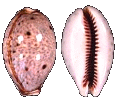
Lyncina lynx
(Linnaeus, 1758)
to 90 mm.
|
Talparia
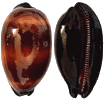
Talparia) talpa
(Linnaeus, 1758)
to 106 mm.
|
Mauritia

Mauritia mauritiana
(Linnaeus, 1758)
to 130 mm.
|
Luria
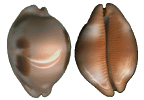
Luria tessellata
(Swainson, 1822)
to 55 mm.
|
Chelycypraea

Chelycypraea testudinaria
(Linnaeus,1758)
to 145 mm.
|
Leporicypraea
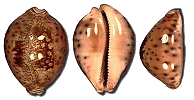
Leporicypraea valentia
(Perry, 1811)
70 100 mm.
|
|
SubFamily:
Erosariinae
"The shells of Erosaria have variable shape, but are often depressed
with angular, usually distincttly pitted margins. The dorsum is covered
with spots of varialble structure, the margins are often spotted. The teethe
are rather angular, leading to a well-defined terminal ridge bordering the
outlet..."
A Guide to Worldwide Cowries: by feliz Lorenze & Alex
Hubert" Page 187
F.H. Troschel (1863) Das Gebiss der Schnecken (Berlin), Vol. 1 p. 205, 210.
|
| |
| Genus:
Naria, Pustularia, Erosaria, Monetaria, Staphylaea, Ipsa, Annepona,
Nucleolaria |
Naria
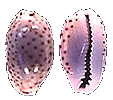
Naria irrorata
(Gray, 1828)
to 17 mm.
|
Pustularia

Pustularia mauiensis
(Burgess, 1967)
to 19 mm.
|
Erosaria
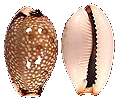
Erosaria gangranosa
(Dillwyn, 1817)
to 28 mm.
|
Monetaria

Monetaria moneta
(Linnaeus, 1758)
to 44 mm.
|
Staphylaea
 Staphylaea
Staphylaea
Staphylaea
Staphylaea
(Linnaeus,1758)
to 29 mm.
|
Ipsa

Ipsa childreni
(Gray, 1825)
to 32 mm.
|
Annepona
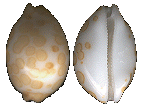
Annepona mariae
(Schilder, 1927)
to 21 mm.
|
Nucleolaria
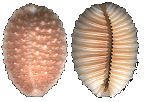
Granulata granulata
(Pease, 1862)
to 49 mm.
|
|
SubFamily:
Bernayinae
Rather large shells, solid in texture, with shell produced extremities
and callous margins. Columellar teeth usually tend to become obsolete midway,
they are comletely absent in some fossil and living species. Profusely mottled
or characteristically marked dorsum, varying in all shades of color. Bandinf
always indistinct and confuse. Fossula smooth and rather reduced. Teeth
never extend far into lips..."
A Guide to Worldwide Cowries: by feliz Lorenze & Alex
Hubert" Page 33
F.A. Schilder (1927) Arch. Naturgesch., Vol. 91/A10, p.88 |
| |
| Genus:
Zoila, Bernaya, Barycypraea |
Zoila
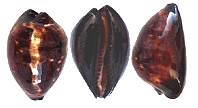
Zoila decipiens
(Smith, 1880)
to 70 mm.
|
Bernaya
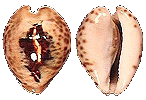
Bernaya teulerei
(Cazanavette, 1846)
to 67 mm.
|
Barycypraea
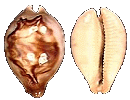
Barycypraea fultoni
(Sowerby, 1903)
to 72 mm.
|
|
|
SubFamily: Cypraeovulinae
Large group of smaller shells with variable features. Dorsum mainly
profusely mottled of regularity spotted and blotched... Most species have
a reduced and smooth fossula...."
"A Guide to Worldwide Cowries: by feliz Lorenze
& Alex Hubert" Page 33
F.A. Schilder (1927) Arch. Naturgesch., Vol. 91/A10, p.68
|
| |
Genus:
Cypraeovula,
Erronea, Umbilia, Austrocypraea, Bistolida, Notocypraea, Cribrarula, Blasicrura,
Palmadusta, Notadusta, Purpuradusta, Nesiocypraea, Chimaeria
|
|
Cypraeovula
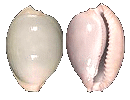
Cypraeovula) cruickshanki
(Kilburn, R.N., 1972)
to 34 mm.
deep water species
|
|
Umbilia
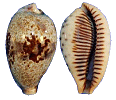
Erronea pulchella pericalles
(Melvill & Standen 1904)
to 40 mm
|
Umbilia
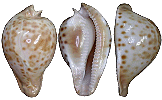
Umbilia capricornica Lorenz, 1989
to 94 mm.
|
Austrocypraea
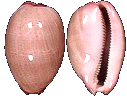
Austrocypraea reevei
(Sowerby I, 1832)
to51 mm.
|
Bistolida
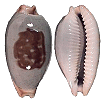
Bistolida diauges
(Melvill, J.C., 1888)
to 42 mm.
|
Notocypraea
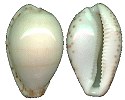
Notocypraea comptonii mayi
(Beddome, 1898)
|
Cribrarula

Cypraea gaskoinii
(Reeve,1846)
to 30 mm.
|
Palmadusta
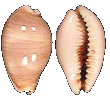
Palmadusta clandestina moniliaris
(Lamarck, J.B.P.A. de, 1810)
to 26 mm.
|
Notadusta
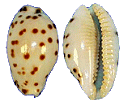
Notadusta punctata berinii
(Dautzenberg 1906)
to 22 mm.
|
Purpuradusta
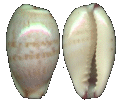
Purpuradusta fimbriata quasigracilis
(Lorenz, F. Jr., 1989)
to 20 mm.
|
Nesiocypraea
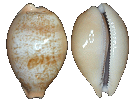
Nesiocypraea langfordi langfordi
(Kuroda, T., 1938)
to 70 mm.
|
Chimaeria
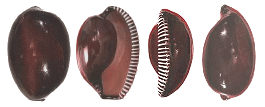
Chimaeria incomparabilis
(Briano, 1993)
to 93 mm.
|
|
|
|
Family:
Ovulidae
(Egg Shells)
"False cowries of the Ovulidae family are members of the same superfamily,
as the Cypraeidae. They usually have smaller shells but otherwise resemble
the Cypraeidae and share similar mantle protective habits. Archerd
Collection |
| |
|
Genus: Ovula,
Volva, Calpurnus, Simnia, Neosimnia, Primovula, Prosimnia, Pseudocypraea,
Pseudosimnia, Procalpurnus, Diminovula, Phenacovolva, Prionovolva, Margovula,
Dentiovula, Habruprionovolva, Kuroshiovolva, Cymbovula, Hiatavolva, Lacrima,
Labiovolva, Xandarovula, Aperiovula, Crenavolva, Serratovolva, Stohleroma,
Rotaovula, Cuspivolva, Carpiscula, Subsimnia, Simnialena, Spiculata, Dissona,
Sandalia, Aclyvolva, Turbovula, Testudovolva, Lunovula
Ovula
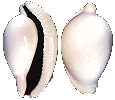
Ovula ovum
(Linnaeus, C., 1758)
to 96 mm.
|
Volva

Volva volva
(Linnaeus, 1758)
to 134 mm.
|
Calpurnus
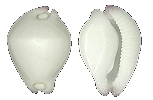
Calpurnus
verrucosus
(Linnaeus, C., 1758)
to 35 mm.
|
Simnia

Simnia rufa
(Sowerby, 1832)
|
Neosimnia

Neosimnia spelta
(Linnaeus, 1758)
11 mm. up
|
Primovula

Prionovolva pudica wilsoniana (Cate, 1973 )
16 mm. up
|
Prosimnia

Prosimnia semperi (Weinkauff, 1881)
10 mm. up
|
Pseudocypraea

Pseudocypraea adamsonii (Sowerby II, 1832)
8 mm. up
|
Pseudosimnia

Pseudosimnia sinensis (Sowerby, 1874)
17 mm. up
|
Procalpurnus
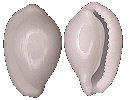
Procalpurnus lacteus
(Lamarck, 1810)
9 mm. up
|
Diminovula

Diminovula punctata (Duclos, 1831)
7 mm. up
|
Phenacovolva

Phenacovolva angasi (Reeve, 1865)
20 mm. up
|
Prionovolva

Primovula formosa
(Adams & Reeve, 1848)
13 mm. up
|
Margovula
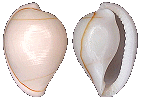
Margovula schilderorum
( Cate, 1973)
19 mm
|
Dentiovula

Dentiovula dorsuosa (Hinds, 1844)
11 mm. up
|
Habruprionovolva
see image
Habruprionovolva manifesta
(Iredale, T., 1936)
9 mm
|
Kuroshiovolva

Kuroshiovolva shingoi
(Azuma, M. & C.N. Cate, 1971)
to 21 mm
|
Cymbovula

Cymbovula massierorum
( Fehse, 1999 )
13 mm.
|
Hiatavolva

Hiatavolva brunneiterma (Cate, 1969)
19 mm. up
|
Lacrima
unable to locate image
|
|
Labiovolva
unable to locate image
|
Xandarovula

Xandarovula formosana
(Azuma, M., 1972)
|
Aperiovula
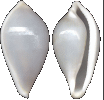
Aperiovula adriatica
(Sowerby, G.B. I, 1828 )
to 25 mm.
|
Crenavolva

Crenavolva striatula (Sowerby, 1828)
8 mm. up
|
Serratovolva
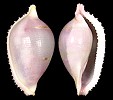
Serratovolva dondani
(Cate, C.N., 1964)
11 - 16 mm
|
Stohleroma
unable to locate image
|
Rotaovula

Rotaovula hirohitoi
(Cate, C.N. & M. Azuma in Cate, C.N., 1973)
7 mm .
|
Cuspivolva

Cuspivolva cuspis
(Cate, C.N., 1973)
9 mm
|
Carpiscula

Carpiscula bullata
(Adams, A. & L.A. Reeve, 1848)
12 mm
|
Subsimnia
unable to locate image
|
Simnialena

Simnialena
uniplicata
(Sowerby, G.B. II, 1848)
12 - 21 mm.
|
Spiculata

Spiculata loebbeckeana
(Weinkauff, H.C., 1881)
16 mm.
|
Dissona

Dissona hasta
Cate, C.N. & M. Azuma in Cate, C.N., 1973
|
Sandalia

Sandalia triticea
(Lamarck, J.B.P.A. de, 1810)
15 mm.
|
Aclyvolva

Aclyvolva lanceolata
(Sowerby, G.B. II, 1848) 20 mm
|
Turbovula

Turbovula fusula
Cate, C.N. & M. Azuma in Cate, C.N., 1973
|
Testudovolva
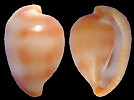
Testudovolva orientis
(Cate,
C.N., 1973)
7 mm.
|
Lunovula
unable to locate image
|
|
|
| |
|
|
SuperFamily:
Velutinoidea |
| |
Family:
Lamellariidae
"Lamellariids,
or as they now should be called, velutinids,(formerly Family Lamellariidae),
are caenogastropod snails, closely related to the Triviidae. In most
velutinids the shell is open and flattened, much like a small abalone
shell (Haliotidae), and at least partially enveloped by the fleshy
mantle. This gives them a fleshy shell-less appearance which often
causes them to be mistaken for sea slugs. In most cases when they
are crawling a pair of head tentacles will emerge from beneath the
body, instantly showing that these are not opisthobranch sea slugs.
Another character is the anterior siphon above the head which opens
into the mantle cavity.
Velutinids all
seem to feed on colonial ascidians and many, like the species illustrated,
are well camouflaged by their similar colour. Some species however,
including some of the large tropical species of Coriocella, are
very brightly coloured. This may be a defensive response, as described
for many nudibranchs..." SeaSlug
Forum
|
| |
 |
Lamellaria
latens
(Müller, O.F., 1776)
10 - 13 mm
|
|
| |
|
Genus:
Lamellaria,
Coriocella, Velutella, Chelyonotus, Onchidiopsis,
Caledoniella, Marseniopsis, Mysticoncha |
Family:
Triviidae
(Bean cowries)
"Triviids
have usually been considered relatives of the cowries [Fam: Cypraeidae]
but are in fact more closely related to the Velutinidae also known as the
Lamellariidae(see above). The inflated cowry-like
shell is at least partially enveloped by fleshy mantle lobes, which can
give them a fleshy shell-less appearance which often causes them to be mistaken
for sea slugs. In most cases when they are crawling a pair of head tentacles
will emerge from beneath the body, with basal eyes, instantly showing that
these are not opisthobranch sea slugs. Another character is the single anterior
siphon above the head which opens into the mantle cavity. Velutinoideans
all seem to feed on colonial ascidians..."
SeaSlug Forum |
| |
SubFamily:
Eratoinae
Eratoinae shells are high spired and smooth with only the outer lip
expanded and toothed. These are predatory molluscs which feed by boring
into the bodies of ascidians and using their proboscis to suck up
the content. They are found in temperate and warm seas.
|
| |
|
Proterato
(Sulcerato) angistoma
(Sowerby, G.B. II, 1832)
to 5 mm
|
|
| |
Genus:
Erato, Proterato, Hespererato, Alaerato |
SubFamily:
Triviinae:
Shells of the subfamily
Triviinae are cowry-like in shape, but are sculptured with strong
ribs across the whole shell surface. Most are uniformly white or pink,
with a few having brown bands or spots. |
| |
|
Trivirostra
exigua
(Gray, 1831)
5 mm.
|
|
| |
Genus:
Trivia, Triviella, Niveria, Pusula, Dolichupis, Trivellona, Robertotrivia,
Discotrivia, Circumscapula |
| |
|
|
SuperFamily:
Naticoidea |
| |
Family:
Naticidae (Moon Shells)
"Moon shells are snail-like globular forms with a half moon shaped
aperture. Some flattened, disk-like species also exist. Typically, a thick
rib-like callus obscures the umbilicus, and the aperture lip is fringed
by a thin sharp edge. In life, mantle flaps from each side cover the shell,
protecting its lustrous finish.
These molluscs are largely found in sea floor sand of the tropics, but also
in waters beyond the Arctic and Antarctic Circles. They make a living by
plowing just below the surface. When they find another mollusc, it is enveloped
by their massive foot --often too large to be withdrawn into the shell...."
Archerd
Collection |
| |
| SubFamily:
Ampullospirinae |
|
Globularia
fluctuata
( Sowerby, 1825)
|
|
| |
Genus:
Pseudopolinices |
| SubFamily:
Naticinae |
|
Natica
(Natica) stellata
(Hedley, C., 1913)
32 mm.
|
|
| |
Genus:
Natica,
Naticarius, Tectonatica, Cryptonatica, Friginatica, Tanea, Notocochlis,
Tasmatica, Glyphepithema |
| SubFamily:
Polinicinae |
|
Polinices
(Polinices) aurantium
(Röding, P.F., 1798)
to 45 mm
|
|
| |
Genus:
Polinices,
Lunatia, Kerguelenatica, Falsilunatia, Sinuber |
| SubFamily:
Sininae |
|
Sinum
incisum
(Reeve, L.A., 1864)
35 mm
|
|
| |
Genus:
Sinum, Eunaticina, Sigatica, Gennaeosinum |
| |
|
|
SuperFamily:
Tonnoidea |
| |
Family:
Bursidae (Frog shells)
Frog shells are distinguished by a deep slot for the posterior siphon
...The shells are heavy and generally have no more than two varices
per whorl. This small family is typically found living in or under
corals, in tropical and semitropical waters... Archerd
Collection
|
| |
|
Bufonaria
(Bufonaria) margaritula
(Deshayes, G.P., 1832)
25 - 60 mm
|
|
| |
|
Genus:
Bursa, Bufonaria, Tutufa |
Family:
Ficidae (Fig shells)
Fig shellsare thin, somewhat fig shaped shells. Species in the genus
Ficus are mainly found in tropical seas living on sand or mud intertidally
or in shallow water, while the recently discovered genus Thalassocyon
occurs at abyssal depths. |
| |
|
Ficus
ficus
(Linnaeus, C., 1758)
40 - 120 mm
|
|
| |
|
Genus:
Ficus, Thalassocyon |
| Family:
Pisanianuridae |
| |
|
|
Pisanianura
breviaxe
(Kuroda, T. & T. Habe in Habe, T., 1961)
15 - 46 mm
|
|
| |
|
Genus:
Pisanianura |
Family:
Laubierinidae
The family Laubierinidae was erected in 1990 for three rare, deep
water species in the superfamily Tonnoidea. Specimens of all the species
are exceptionally rare, only known from a few localities where very
deep sea sampling has taken place. URL |
| |
|
Akibumia
orientalis
(Schepman, M.M., 1909)
|
|
| |
|
Genus:
Akibumia, Laubierina |
Family:
Personidae (Distorted
whelks)
The Personidae is a small family, only about 25 species, formerly
regarded as being part of the Ranellidae. All species in the family
are distorted to some extent, due to the necessity for whorls to grow
over the expanded varix of the earlier whorl. URL |
| |
|
Distorsio
anus
(Linnaeus, C., 1758)
33 - 100 mm
|
|
| |
|
Genus:
Distorsio, Distorsionella, Personopsis, Distorsomina |
Family:
Ranellidae (Tritons)
The family Ranellidae, previously known as Cymatiidae, are medium to large
sized, heavy shells often with multiple varices, covered with a brown periostracum.
The family has representatives from the intertidal down to abyssal depths,
often with very wide geographical ranges. URL |
| |
| SubFamily:
Ranellinae |
| |
|
Biplex
perca
(Perry, G., 1811)
31 - 100 mm
|
|
| |
Genus:
Argobuccinum, Gyrineum, Biplex, Ranella, Fusitriton, Halgyrineum |
| SubFamily:
Cymatiinae |
| |
|
Cymatium
(Monoplex) pileare
(Linnaeus, C., 1758)
44 - 120 mm
|
|
| |
Genus:
Cabestana, Cymatium, Charonia, Sassia |
Family:
Tonnidae (Tun Shells)
The family Tonnidae includes a small number of species with medium-sized
to large shells which are thin for their size, and nearly spherical.
The spire is small, while the body whorl is large and well inflated,
ending in a very wide aperture. The outer surface is usually sculptured
by thick spiral ribs. The animals lack the operculum. Most tun shells
can be found living in sand, in the tropics beyond the edge of the
coral reef. Archerd
Collection |
| |
|
Malea
pomum
(Linnaeus, C., 1758)
40 - 80 mm
|
|
| |
|
Genus:
Tonna, Malea, Eudolium |
Family:
Cassidae
(Helmet Shells)
The Helmet
Shells are heavily constructed, large or medium size shells with a rather
short spire and a well-developed final whorl. The body whorl is voluminous,
and often ornamented with knobs and varices (lengthwise ribs). The callus
is well developed and extends over the entire ventral surface. Coarse teeth
on the inner side of the lip and several prominent columellar folds are
common, but not invariable.
Defining characteristics are: outer lip thickened and recurved on the dorsal
surface to form a prominent helmet-like rim; and, a short syphonal canal
bent backwards and opening toward the dorsal surface. The Family contains
eighty or more living species that live in warm waters around the world.
Archerd
Collection |
| |
| SubFamily:
Cassinae |
| |
|
Cassis
cornuta
(Linné, 1758)
95 - 390 mm
|
|
| |
Genus:
Cassis, Galeodea, Cypraecassis |
| SubFamily:Phaliinae
|
| |
|
Semicassis
(Semicassis) bisulcata
(Schubert & A.J. Wagner, 1829)
25 - 80 mm
|
|
| |
Genus:Phalium,
Semicassis, Casmaria, Echinophoria |
| SubFamily:
Oocorythinae |
| |
|
Oocorys
alcocki
(Smith, E.A., 1906)
50 - 115 mm
|
|
| |
Genus:
Oocorys, Hadroocorys |


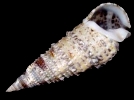
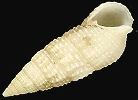
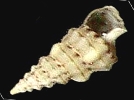
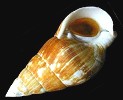
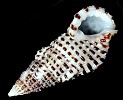
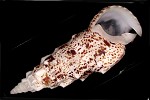
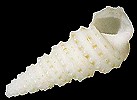

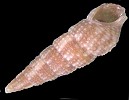
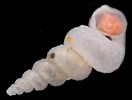




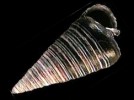
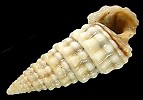


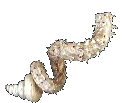




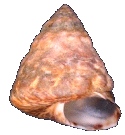


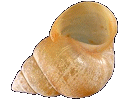











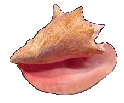
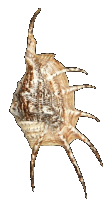



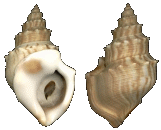
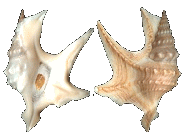
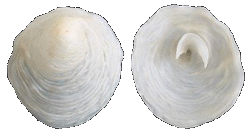

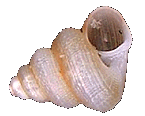
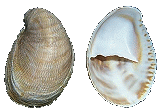
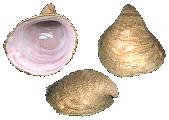
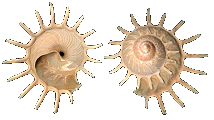
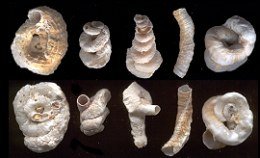

 pustulata
pustulata 










 Staphylaea
Staphylaea
Staphylaea
Staphylaea
















































